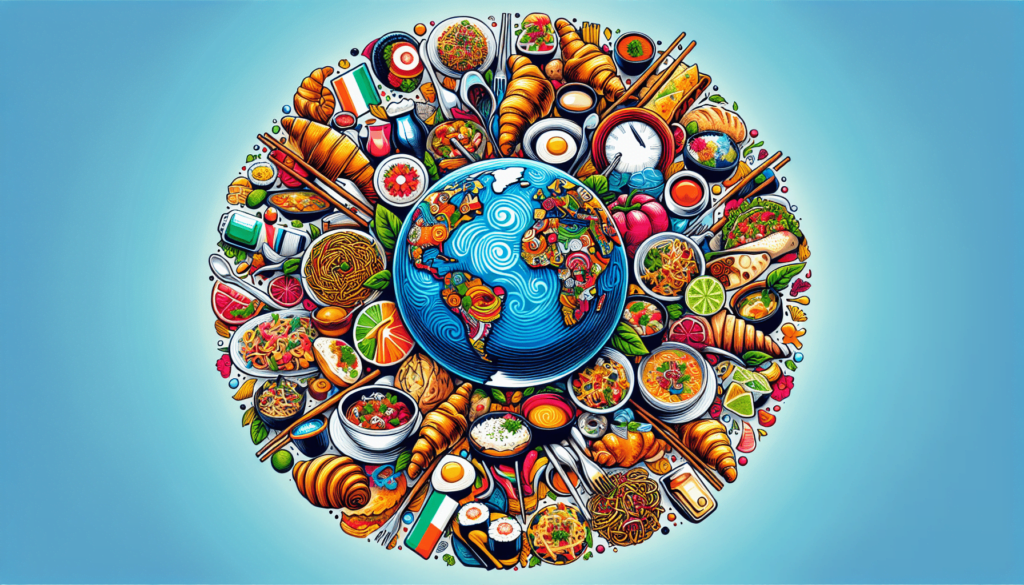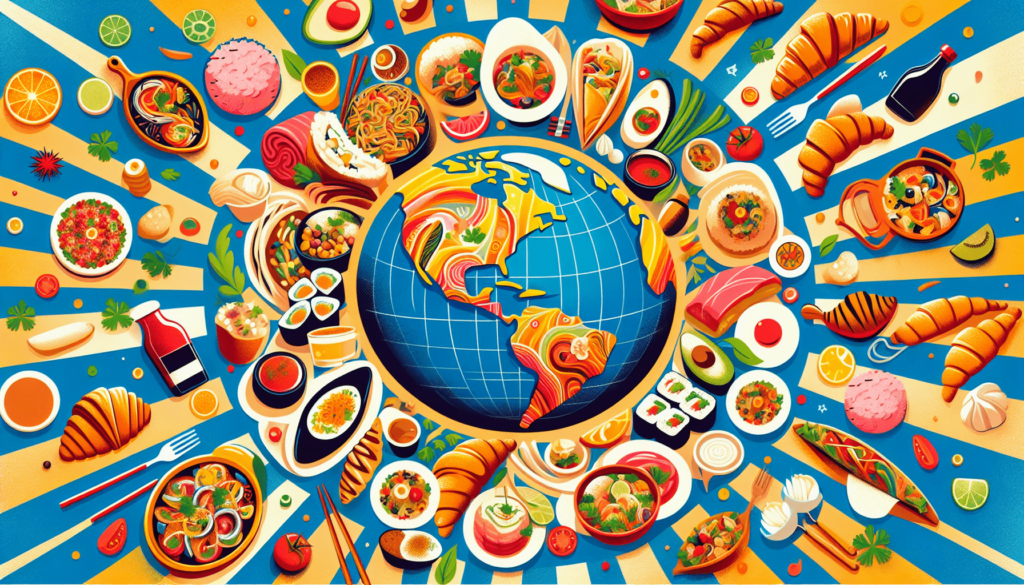Embark on “A Gastronomic Journey: In Search of the Ultimate Bite,” a culinary adventure designed to tantalize your taste buds. This article delves into the historical context of global cuisine, mapping the evolution of flavors that have come to define gastronomic excellence. It navigates through current trends, from the rise of farm-to-table practices to the resurgence of traditional cooking methods, offering expert insights and detailed explorations. You’ll discover riveting case studies that illustrate these culinary shifts, compare diverse perspectives on gourmet innovation, and assess their broader implications for chefs and food enthusiasts worldwide. As you journey through these savory landscapes, you’ll be inspired to ponder the future directions and impact of these delicious developments on our dining experiences.
Table of Contents
A Gastronomic Journey: In Search of the Ultimate Bite
Have you ever wondered what makes a meal truly unforgettable, that elusive “ultimate bite” that lingers in your memory and taunts your taste buds? It’s a question that has fascinated chefs, food critics, and diners alike for centuries.
Overview
Cuisine is not merely about sustenance; it’s an art form, a cultural expression, and sometimes, a transformative experience. In today’s world, where culinary possibilities are endless and food trends evolve rapidly, the quest for the ultimate bite has never been more relevant. We’re diving deep into this delicious mystery to explore what makes a single mouthful transcend mere food and turn into an extraordinary experience.
Thesis Statement
The search for the ultimate bite is a complex journey that intertwines history, modern trends, and personal preferences. By exploring historical contexts, current trends, and key concepts, we aim to uncover the essential ingredients that contribute to this extraordinary gastronomic sensation.
Historical Context
The journey of discovering the ultimate bite is deeply rooted in history. Across different cultures and epochs, society’s relationship with food has evolved dramatically. For instance, the lavish banquets of ancient Rome, which were marked by opulence and indulgence, have influenced culinary practices for centuries. The Middle Ages saw food as a status symbol, while the Renaissance ushered in a new era of culinary arts, emphasizing the aesthetics of food.
In Japan, the ancient practice of Kaiseki, a multi-course meal that highlights seasonal ingredients and meticulous preparation, dates back to the 16th century. Kaiseki is often cited as a precursor to today’s tasting menus, a concept that seeks to offer a series of “ultimate bites” in one meal. This historical tapestry shows us that the quest for the ultimate bite isn’t a new phenomenon. Instead, it’s a tradition deeply embedded in human history, evolving with each passing era and culture.
The Age of Exploration
The Age of Exploration was a pivotal period for global cuisine. Explorers and traders exchanged spices, ingredients, and cooking techniques, significantly expanding culinary possibilities. The introduction of tomatoes to Europe, spices from the East Indies, and even cacao from the Americas transformed traditional recipes and laid the groundwork for contemporary gastronomy.
The French Influence
The influence of French cuisine cannot be overstated. Auguste Escoffier’s revolutionary techniques and his classical French cuisine are still benchmarks in the culinary world. His principles of sauce-making, kitchen hierarchy, and menu structuring aimed at creating the ultimate bite long before the term became popular.

Current Trends
In the modern era, technology and globalization have further broadened our culinary horizons. Farm-to-fork movements emphasize the importance of fresh, local ingredients. Meanwhile, molecular gastronomy pushes the boundaries of traditional cooking techniques to create innovative dishes. The fusion of these old and new methods forms the cornerstone of today’s quest for the ultimate bite.
Farm-to-Table Movement
One of the most significant current trends in gastronomy is the farm-to-table movement. This approach emphasizes the importance of fresh, locally-sourced ingredients, often organic and sustainably grown. The belief is that by using the highest quality ingredients, the dish will naturally contain the elusive ultimate bite. This trend has seen a rise in farmer’s markets and the prevalence of seasonal menus in high-end restaurants.
Molecular Gastronomy
On the other end of the spectrum, molecular gastronomy combines science and art to deconstruct and then re-engineer food in innovative ways. Techniques like spherification, foam creation, and sous-vide cooking are just some methods employed to manipulate texture, flavor, and appearance. Chefs like Ferran Adrià and Heston Blumenthal have become icons in this field, creating experiences that are as much about performance as they are about taste.
Celebrity Chefs and TV Shows
The influence of celebrity chefs and culinary TV shows cannot be ignored. Shows like “Chef’s Table” and “MasterChef” have turned the art of cooking and tasting into mainstream entertainment. They’ve brought home the idea that creating that ultimate bite is a journey worth taking, inspiring home cooks and professional chefs alike.
Key Concepts and Definitions
To understand this journey comprehensively, let’s break down some key concepts and definitions.
Umami
Often referred to as the fifth taste, umami is a savory flavor profile that can elevate a dish from ordinary to extraordinary. It’s found in ingredients like soy sauce, aged cheese, and tomatoes and can be the secret weapon in creating the ultimate bite.
Mouthfeel
Mouthfeel pertains to the physical sensations in the mouth produced by a particular food or drink. It includes textures, such as creamy, crunchy, and chewy, which play a crucial role in the overall dining experience.
Flavor Pairing
Flavor pairing is the science of combining different foods that complement each other’s aromas and taste profiles. It’s based on the theory that foods with similar chemical compounds often taste good together. The perfect pairing can result in a bite that’s more than the sum of its parts.
Detailed Exploration
To further our understanding of the ultimate bite, we need to delve into the attributes that contribute to it. This involves dissecting flavors, textures, and the psychological aspects of dining.
Building the Perfect Bite: A Symbiosis of Elements
Creating the ultimate bite involves a harmonious blend of flavors, textures, and aromas. A perfect example of this is the classic caprese salad. The creaminess of the mozzarella, the juiciness of the tomatoes, the peppery taste of the basil, and the acidity of the balsamic vinegar work together to create a bite that is balanced and complex.
The Role of Sensory Experience
Eating is a multisensory experience. The sight of a beautifully plated dish, the smell of herbs and spices, the sound of a crisp bite, and the taste and texture all combine to create an extraordinary sensory experience. For instance, Japanese cuisine’s Omakase meal, which is a chef’s tasting menu, is designed to be a sensory journey, with each course meticulously planned to engage and delight the senses.

Example 1: A Case Study on El Bulli
El Bulli, Ferran Adrià’s famed restaurant, serves as an excellent case study for the pursuit of the ultimate bite. Located in a remote cove in Spain, El Bulli was known for its avant-garde techniques and exceptional creativity. Each dish was a work of art designed to surprise and delight the diner. For instance, their iconic “spherified olive” appears to be an ordinary olive but bursts with liquid and intense flavors when bitten into, providing a memorable and unexpected ultimate bite.
The Analysis
El Bulli’s success lay not only in the novelty of its dishes but also in their execution. Ingredients were of the highest quality, and techniques were precise and innovative. Ferran Adrià studied both the ingredients and the guests to understand their preferences and expectations, making each meal a tailored experience. This approach is a vital lesson in the quest for the ultimate bite: it’s not just about the food but the entire experience.
Example 2: The Perfect Steak
Consider the simple yet profoundly satisfying experience of eating a perfectly cooked steak. The key to an extraordinary steak lies in several factors: the quality of the meat, the cut, the seasoning, and the cooking technique. A ribeye, known for its marbling, when seasoned generously with salt and pepper and seared to a perfect medium-rare, can provide a bite that is unparalleled in its simplicity and satisfaction.
The Science Behind It
Steak benefits from the Maillard reaction, a chemical process that occurs when proteins and sugars are exposed to high heat, creating complex flavors and that coveted crust. When combined with the tenderness of a medium-rare center, each bite delivers a contrast of textures and a depth of flavors that define the ultimate bite.
Comparison of Different Perspectives
To appreciate the intricacies involved in the ultimate bite, it’s important to compare various culinary philosophies and techniques.
Classical French vs. Modernist Cuisine
Classical French cuisine, with its stringent techniques and focus on sauces and meticulous preparation, aims for perfection through tradition and skill. In contrast, modernist cuisine, with its focus on innovation and breaking culinary boundaries, seeks to surprise and challenge the diner.
French:
- Technique-driven
- Emphasis on tradition
- Focus on sauces and preparation
Modernist:
- Innovation-driven
- Emphasis on novelty
- Focus on molecular techniques
Cultural Influence
The cultural background of cuisine also plays a significant role in shaping what is considered the ultimate bite. Italian cuisine, for example, places a high value on simplicity and quality ingredients. In contrast, Japanese cuisine often involves a series of delicate, well-balanced flavors that together create a culinary harmony.
Impact Assessment
The differing philosophies and techniques have far-reaching impacts on the dining experience. For instance, a classical French meal may leave the diner feeling sophisticated and satiated, while a modernist meal might be more about the experience and the story behind each dish. By examining these impacts, we get a fuller understanding of what different culinary traditions can offer in the quest for the ultimate bite.
Future Directions and Implications
Where does the quest for the ultimate bite take us next? With advances in technology and a growing appreciation for sustainable and locally-sourced ingredients, the future of gastronomy looks incredibly promising.
Predictions
One potential future direction is the increased use of AI and data analytics to tailor dining experiences to individual preferences. Imagine a restaurant that knows your taste palette and can create a personalized menu designed to deliver your ultimate bite. Another possibility is a greater focus on sustainability, with restaurants becoming zero-waste and self-sufficient in producing their own ingredients.
Implications
These advancements could significantly impact not just the culinary world but society at large. A deeper connection with food could lead to healthier eating habits, reduce waste, and highlight the importance of sustainability. Furthermore, the globalization of dining experiences could lead to a more united world where food serves as a medium for cultural exchange and understanding.
Conclusion
Recap
In our journey to uncover what makes an ultimate bite, we’ve navigated through historical contexts, current trends, and diverse culinary philosophies. From the importance of flavor pairing and umami to the elegance of classical French cuisine and the innovation of molecular gastronomy, each element contributes to crafting that elusive perfect bite.
Final Thought
So, the next time you bite into something truly extraordinary, consider the history, the ingredients, and the techniques that made it possible. Food is not just nourishment but a multidimensional experience that holds the power to transcend the ordinary.
Engagement
We’d love to hear about your ultimate bite experiences! Share your stories in the comments, or explore our recommended resources to dive deeper into the world of culinary excellence.
Credible Sources
- Adrià, Ferran. (2003). A Day at el Bulli
- Escoffier, Auguste. (1903). Le Guide Culinaire
- McGee, Harold. (2004). On Food and Cooking: The Science and Lore of the Kitchen
- Myhrvold, Nathan. (2011). Modernist Cuisine: The Art and Science of Cooking
- Pollan, Michael. (2006). The Omnivore’s Dilemma: A Natural History of Four Meals
These resources provide additional insights and detailed understandings for those interested in diving deeper into the fascinating world of gastronomy.
JOURNEY THROUGH CUISINE: THREE DELICIOUS WAYS TO GO ON A GASTRONOMIC DISCOVERY
